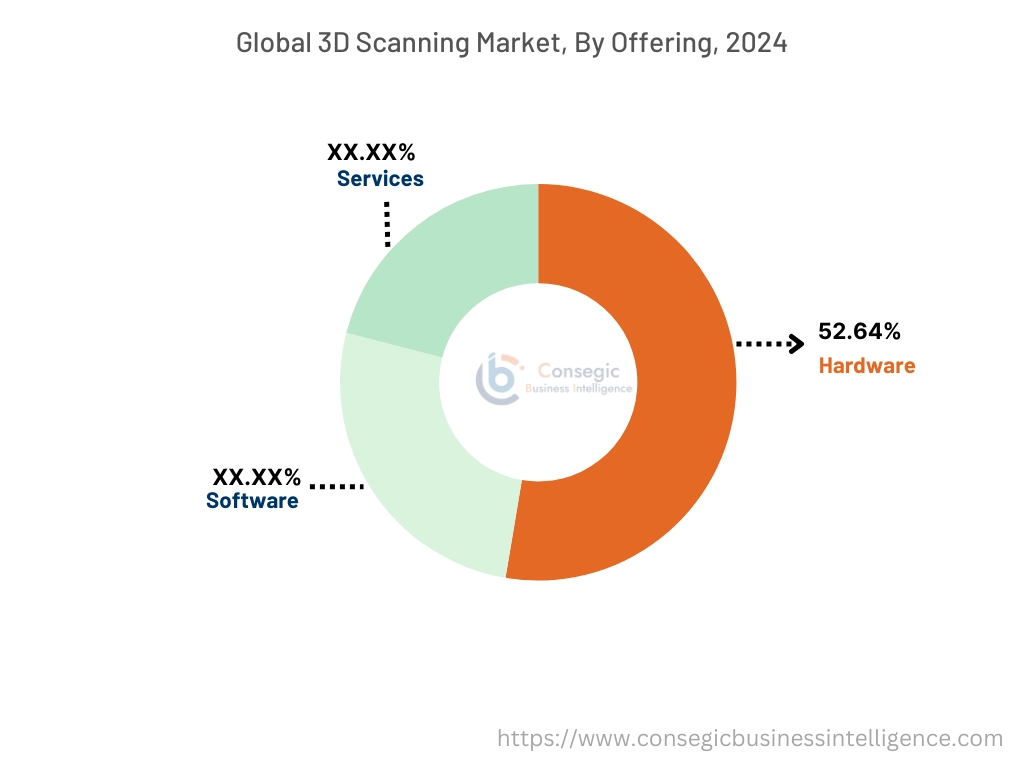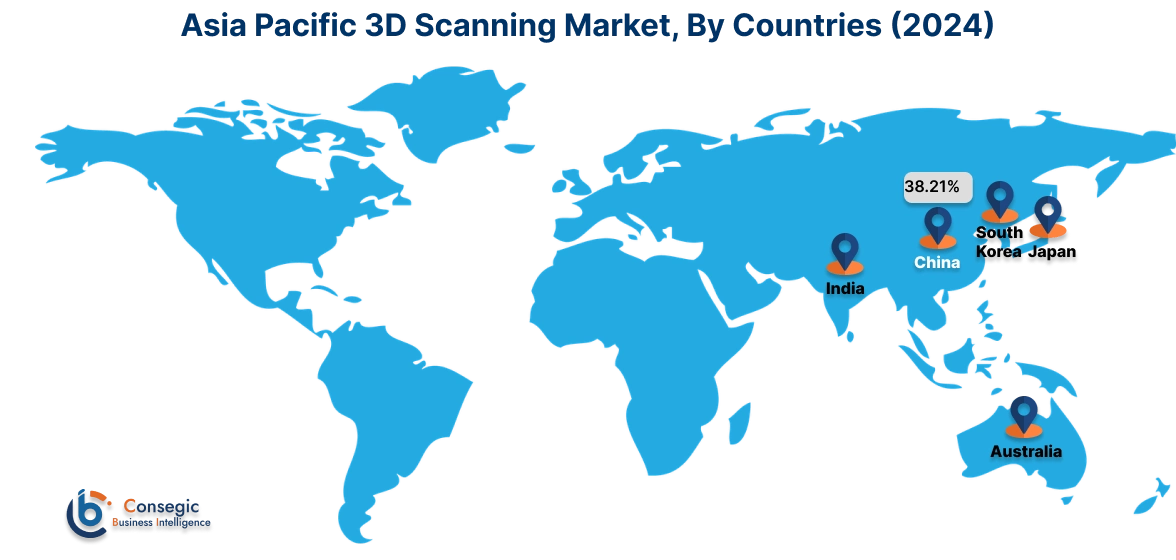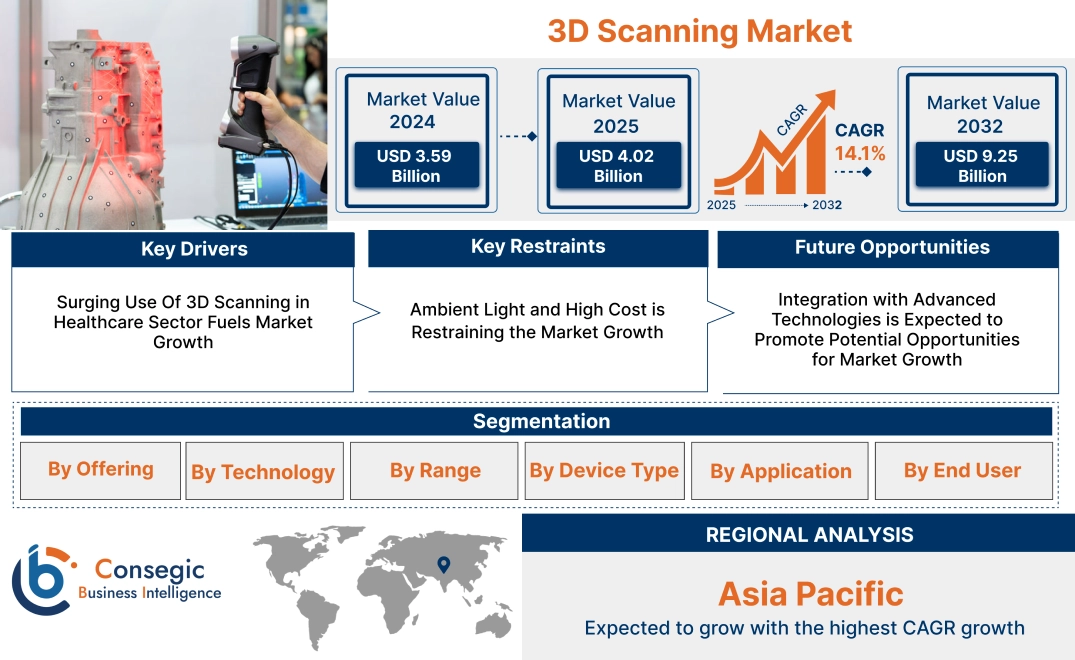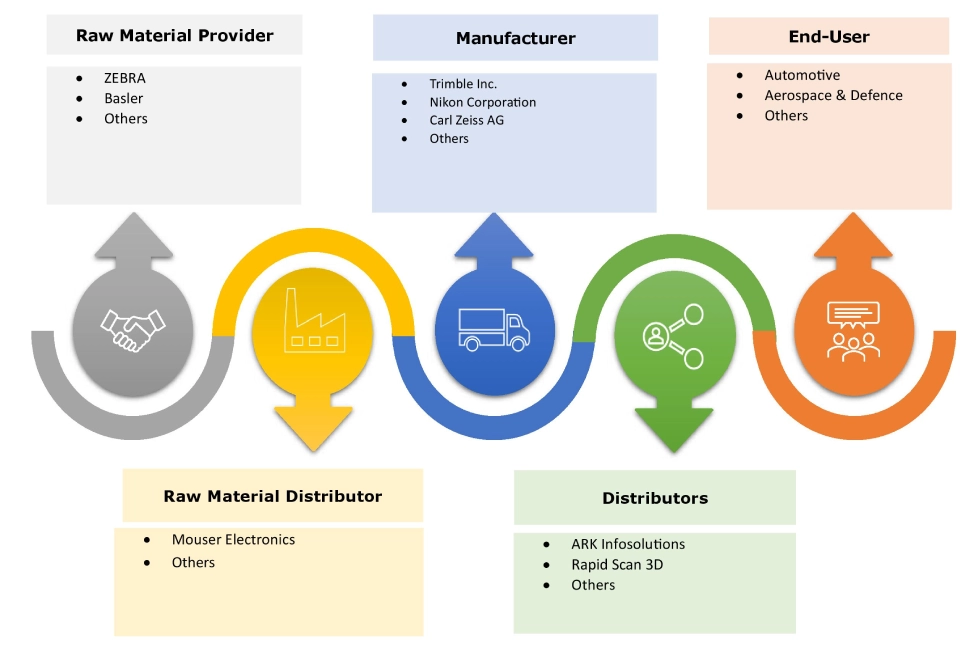- Summary
- Table Of Content
- Methodology
3D Scanning Market Size:
3D Scanning Market size is estimated to reach over USD 9.25 Billion by 2032 from a value of USD 3.59 Billion in 2024 and is projected to grow by USD 4.02 Billion in 2025, growing at a CAGR of 14.1% from 2025 to 2032.
3D Scanning Market Scope & Overview:
3D scanning is a technology which captures the geometry and physical characteristics of objects to convert it into a digital 3D model which in turn is utilized for digital representation and analysis of objects. Additionally, the advantages including high accuracy, rapid data capture, and non-contact technology among others are driving the 3D scanning market demand. Further, the rising adoption to bridge the gap between the physical and digital realms is driving the 3D scanning market growth. Also, the devices are widely utilized in automotive, aerospace and defence industries among others for rapid prototyping, and quality control is driving the 3D scanning industry.
Key Drivers:
Surging Use Of 3D Scanning in Healthcare Sector Fuels Market Growth
The 3D scanner plays a vital role in providing detailed anatomical visualizations which are essential for accurate diagnosis, treatment planning, and others are driving the 3D scanning market growth. Further, the AI integration for faster and more accurate diagnostics is driving the 3D scanning market demand. Additionally, rising adoption for creating precise 3D models for Prosthetics and Implants is driving the market progress.
- For instance, in February 2024, Royal Philips launched Philips CT 5300 equipped with AI capabilities. The scanner is designed for diagnosis, interventional procedures and screening as well as plays an important role in the diagnosis of cardiac disease.
Therefore, the rising adoption in healthcare sector is driving the adoption of scanners, in turn proliferating the growth of the market.
Key Restraints:
Ambient Light and High Cost is Restraining the Market Growth
The ambient light interferes with the scanning process in turn negatively impacting the accuracy of 3D scans in turn hindering the 3D scanning market expansion. Additionally, the industrial 3D scans are expensive for adoption in small and medium-sized enterprises. Further, the scanning service is dependent on complexity, size, and quality requirements of the object being scanned in turn restraining the market adoption.
Therefore, the high costs of scanning service and hindrance in accuracy caused by ambient light is restraining the 3D scanning market expansion.
Future Opportunities :
Integration with Advanced Technologies is Expected to Promote Potential Opportunities for Market Growth
The technological advancement in the 3D scanning by integrating LiDAR and imaging sensors for providing 3D structure as well as adding color and texture to the object is paving the way for 3D scanning market opportunities. Additionally, the increased speed and accuracy in capturing data from an object's surface is driving the market adoption.
- For instance, in February 2025, 3DMakerpro launched Eagle Series Spatial 3D Scanners embedded with LiDAR and imaging sensors to capture data for applications in reverse engineering, digital twinning and others.
Hence, the rising adoption of LiDAR and imaging sensors is anticipated to increase the utilization, in turn promoting prospect for 3D scanning market opportunities during the forecast period.
3D Scanning Market Segmental Analysis :
By Offering:
Based on the offering, the market is segmented into hardware, software, and services.
Trends in the Offering:
- The revolutionizing of manufacturing and prototyping is driving the adoption of services segment which in turn drives the 3D scanning market trend.
- The trend towards creating a user friendly UI in software segment of 3D scan is driving the market progress.
Hardware accounted for the largest revenue share of 52.64% in the year 2024.
- The hardware components include laser, scan heads, mechanical components, power supplies, and calibration equipment, among others.
- Additionally, the advantages of scanning include enhanced accuracy and precision, cost efficiency, and versatility which in turn drives the 3D scanning market size.
- Further, the AI integration with the device is improving the efficiency and precision in data handling and collection in turn driving the 3D scanning market size.
- For instance, in March 2024, 3DMakerpro launched Moose series in 3D scan technology. The device offers remarkable efficiency and precision for handling medium-sized objects
- Thus, according to the 3D scanning market analysis, AI integration is driving the hardware segment.
Software is anticipated to register the fastest CAGR during the forecast period.
- The segment comprise of basic scanning software to advanced reverse engineering and inspection software.
- Additionally, the software offers streamlined user interface and workflow with improved performance in turn boosting the 3D scanning market share.
- Further, the rising demand for creation of digital twin is driving the adoption of software is driving the 3D scanning market share.
- For instance, in June 2024, Polyga Inc. launched PointKit Scan software designed to edit and transform 3D data from any capture device. Additionally, the software offers streamlined user interface and workflow, enhanced mesh optimization tools and other features.
- Therefore, the rising demand for creation of digital twin is anticipated to boost the market during the forecast period.

By Technology:
Based on the technology, the market is segmented into laser pulse based, laser triangulation, laser phase-shift based, and pattern fringe triangulation.
Trends in the Technology:
- The rising need for mapping the exact shape in a 3D model is driving the adoption of pattern fringe triangulation technology.
Laser Triangulation Technology accounted for the largest revenue share in the year 2024.
- Laser triangulation technology derives three-dimensional data with the help of triangulation principle in which laser is the source of illumination.
- Additionally, laser triangulation technology is utilized in various end use industries such as electronics, food and beverage, and automotive among others.
- Also, the technology is utilized for various applications such as inspection, object detection, and process optimization among others.
- Further, the technology provides precise and accurate details of the object is driving the adoption of laser triangulation technology.
- For instance, in September 2022, Solartron launched non-contact laser triangulation sensors, designed for providing enhanced accuracy and efficiency in measurement.
- Thus, the ability to provide precise and accurate details is driving the adoption of laser triangulation technology.
Laser Pulse Based Technology is anticipated to register the fastest CAGR during the forecast period.
- Laser pulse based technology utilizes circuitry for calculating the distance travelled by the laser.
- Also, the advantages of laser pulse based technology include enhanced speed and efficiency, versatility, improved safety, enhanced accuracy, and others.
- Further, the rising adoption of laser pulse based technology in large-scale applications is driving the market progress.
- Therefore, the rising adoption in large-scale applications are anticipated to boost the market during the forecast period.
By Range:
Based on the range, the market is segmented into short range, medium range, and long range.
Trends in the Range:
- The trend towards capturing fine details in design of jewelry is driving the adoption of short range 3D scan device.
- The rising adoption of long range 3D scanner in infrastructure monitoring, and facility layout planning is driving the 3D scanning market trend.
Short Range accounted for the largest revenue share in the year 2024.
- The advantages include high accuracy, portability, and rapid scanning among others are driving the market progress.
- Further, the rising adoption of short range 3D scan in healthcare, jewelry, and consumer electronics for applications such as quality control and reverse engineering is driving the progress of segment.
- Thus, according to the 3D scanning market analysis, rising adoption in healthcare, jewelry and others is driving the short range 3D scan segment.
Medium Range is anticipated to register the fastest CAGR during the forecast period.
- The medium range 3D scan captures larger areas due to improvements in sensor technology as well as adoption of AI and ML.
- Further, the rising adoption of medium range 3D scan in automotive, railway and aerospace industry are driving the market progress.
- For instance, in July 2023, Hexagon launched AS1-XL 3D scan with scan line of 600 millimetres at mid-range. Also, the devices are ideal for scanning large surfaces quickly without losing inspection detail in automotive, rail and aerospace interiors.
- Therefore, the rising adoption in automotive, railway and other industries is anticipated to boost the market during the forecast period.
By Device Type:
Based on the device type, the market is segmented into stationary, handheld, and others.
Trends in the Device Type:
- The rising adoption of handheld scanners in healthcare sector is driving the market progress.
- The integration of stationary scan with robots for automated scanning is driving the market progress.
Stationary accounted for the largest revenue share in the year 2024.
- The stationary scanners offers accuracy, efficiency, and creates detailed digital records of physical objects.
- Further, the demand for large-scale object scanning and quality control is driving the adoption of stationary 3D scanner.
- Additionally, the stationary scanners scan are widely utilized in industries such as automotive, aerospace and manufacturing.
- Thus, as per the market analysis, the need for large-scale object scanning and quality control is driving the adoption of stationary 3D scan.
Handheld is anticipated to register the fastest CAGR during the forecast period.
- The handheld 3D scanners offers portability, versatility, ease of use, with speed and accuracy in turn driving the handheld segment adoption.
- Further, the increasing demand for on-site applications in architecture, engineering, and manufacturing industry is driving the adoption of handheld 3D scanners.
- For instance, in October 2023, Creaform launched HandySCAN 3D line-up designed for accurate 3D measurements of any large and complex surfaces. Also, the device offers seamless integration with any CAD software.
- Therefore, the increasing demand for on-site applications is anticipated to boost the market during the forecast period.
By Application:
Based on the application, the market is segmented into rapid prototyping, reverse engineering, digital twin, virtual simulation, quality control and inspection, and others.
Trends in the Application:
- The adoption of 3D scan for rapid prototyping in healthcare sector is driving the market development.
- The increasing focus towards medical training and personalized surgical plans with the help of virtual simulation is driving the market adoption.
Reverse Engineering accounted for the largest revenue share in the year 2024.
- The rapid innovation and product development in various manufacturing industries is driving the adoption of 3D scanners for reverse engineering applications.
- Further, the increasing focus towards creation of incredibly detailed models with mix of high-quality geometry and texture is driving the market adoption for reverse engineering applications.
- For instance, in September 2024, Artec launched Spider II which is a handheld 3D scanner. The devices are ideal for in-depth reverse engineering and creation of CGI.
- Thus, as per the market analysis, rapid innovation and product development is driving the market adoption for reverse engineering applications.
Digital Twin is anticipated to register the fastest CAGR during the forecast period.
- Industry 4.0 revolution is propelling manufacturers to adopt 3D scanners for digital twin applications to optimize and predict performance as well as make informed decisions.
- Additionally, the digital twin applications are widely utilized for monitoring, analyzing, and designing of various processes involved in various industries.
- Further, the rising adoption of advanced technology such as AI, ML and VR is driving the adoption of 3D scanners for digital twin applications.
- Therefore, the Industry 4.0 revolution and adoption of advanced technology are anticipated to boost the market during the forecast period.
By End User:
Based on the end user, the market is segmented into automotive, industrial manufacturing, aerospace & defense, healthcare, construction, and others.
Trends in the End User:
- The need for precise aircraft inspections and component design is driving the adoption in aerospace & defense sector.
- The rising adoption of advanced technology such as Building Information Modeling (BIM) and AI in construction sector is driving the market progress.
Industrial Manufacturing accounted for the largest revenue share in the year 2024.
- The advent of Industry 4.0 is driving the industrial manufacturing sector towards automation as well as adoption of robotics is driving the market evolution.
- Additionally, the advantages of 3D scan in industrial manufacturing sector include increased efficiency, improved accuracy, reduced cost, enhanced product quality and others.
- Further, the rising adoption of AI with 3D scan in industrial manufacturing for quality control, reverse engineering, and prototyping is propelling the market progress.
- For instance, in March 2025, Backflip AI launched 3D AI foundation model designed for accelerating the repair of industrial manufacturers which in turn prevents costly downtime.
- Thus, as per the market analysis, the rising adoption of AI with 3D scan is driving the market adoption in industrial manufacturing sector.
Automotive is anticipated to register the fastest CAGR during the forecast period.
- The 3D scan is utilized in automotive sector for product development, inspection, and quality control, automate 3D measurement and other activities.
- Additionally, the 3D scan drives applications such as designing, prototyping and reverse engineering among others in automotive sector which in turn drives the market progress.
- Further, the need for high-precision measurements to withstand quality standards is driving the adoption of 3D scan in automotive sector.
- Therefore, the need for high-precision measurements is anticipated to boost the market during the forecast period.
Regional Analysis:
The regions covered are North America, Europe, Asia Pacific, the Middle East and Africa, and Latin America.

Asia Pacific region was valued at USD 0.96 Billion in 2024. Moreover, it is projected to grow by USD 1.08 Billion in 2025 and reach over USD 2.55 Billion by 2032. Out of this, China accounted for the maximum revenue share of 38.21%. The market is mainly driven by industrialization and urbanization. Furthermore, factor including rising adoption in automotive sector is projected to drive the market progress in Asia Pacific region during the forecast period.
- For instance, in January 2022, Topcon based out in Japan launched GTL-1200 scanning robotic total station which capture high-resolution 3D scans driving the adoption in construction sector in turn boosting urbanization in Asia Pacific region.

North America is estimated to reach over USD 3.12 Billion by 2032 from a value of USD 1.22 Billion in 2024 and is projected to grow by USD 1.37 Billion in 2025. The North American region's growing need for precise measurement and quality control offer lucrative growth prospects for the market. Additionally, the progress in automotive prototyping and adoption in healthcare for precise measurements of patients' anatomy is driving the market development.
- For instance, in April 2024, Creaform launched MetraSCAN BLACK+ and BLACK+|Elite which are CMM 3D scanners enabling simple and precise measurement of large parts as well as catering to the needs of quality control experts.
The regional evaluation depicts that the proliferation of Industry 4.0 as well as increasing adoption in healthcare and manufacturing is driving the market in Europe. Additionally, the key factor driving the market is rapid infrastructure development in the Middle East and African region. Further, the growing healthcare and biotechnology is paving the way for the progress of market in Latin America region.
Top Key Players and Market Share Insights:
The global 3D scanning market is highly competitive with major players providing 3D scanning to the national and international markets. Key players are adopting several strategies in research and development (R&D), product innovation, and end user launches to hold a strong position in the 3D scanning industry. Key players in the 3D scanning market include-
- Creaform (USA)
- Artec (Europe)
- Hexagon AB (Sweden)
- Topcon Corporation (Japan)
- Autodesk Inc. (USA)
- Trimble Inc. (USA)
- Nikon Corporation (Japan)
- Carl Zeiss AG (Germany)
- CyberOptics Corp. (USA)
- Mitutoyo Corp. (Japan)
Recent Industry Developments :
Product Launches:
- In October 2024, Revopoint launched MetroX 3D scanner which is embedded with blue laser and blue structured light technology to capture small to medium objects.
Collaborations and Partnerships:
- In February 2024, SAM acquired PrecisionPoint, Inc. to leverage 3D scan services and BIM services for enhanced informative decision making as well as align with companies existing portfolio of managed geospatial services.
3D Scanning Market Report Insights :
| Report Attributes | Report Details |
| Study Timeline | 2019-2032 |
| Market Size in 2032 | USD 9.25 Billion |
| CAGR (2025-2032) | 14.1% |
| By Offering |
|
| By Technology |
|
| By Range |
|
| By Device Type |
|
| By Application |
|
| By End User |
|
| By Region |
|
| Key Players |
|
| North America | U.S. Canada Mexico |
| Europe | U.K. Germany France Spain Italy Russia Benelux Rest of Europe |
| APAC | China South Korea Japan India Australia ASEAN Rest of Asia-Pacific |
| Middle East and Africa | GCC Turkey South Africa Rest of MEA |
| LATAM | Brazil Argentina Chile Rest of LATAM |
| Report Coverage |
|
Key Questions Answered in the Report
How big is the 3D scanning market? +
The 3D scanning market size is estimated to reach over USD 9.25 billion by 2032 from a value of USD 3.59 billion in 2024 and is projected to grow by USD 4.02 billion in 2025, growing at a CAGR of 14.1% from 2025 to 2032.
What specific segmentation details are covered in the 3D scanning report? +
The 3D scanning report includes specific segmentation details for offering, technology, range, device type, application, end user, and regions.
Which is the fastest segment anticipated to impact the market growth? +
In the 3D scanning market, the handheld segment is the fastest growing segment during the forecast period due to increasing demand for on-site applications.
Who are the major players in the 3D scanning market? +
The key participants in the 3D scanning market are Creaform (USA), Artec (Europe), Hexagon AB (Sweden), Topcon Corporation (Japan), Autodesk Inc. (USA), Trimble Inc. (USA), Nikon Corporation (Japan), Carl Zeiss AG (Germany), CyberOptics Corp. (USA), Mitutoyo Corp. (Japan) and others.
What are the key trends in the 3D scanning market? +
The 3D scanning market is being shaped by several key trends including trend towards need for precise aircraft inspections and component design as well as increasing focus towards medical training and personalized surgical planning and other are the key trends driving the market.



